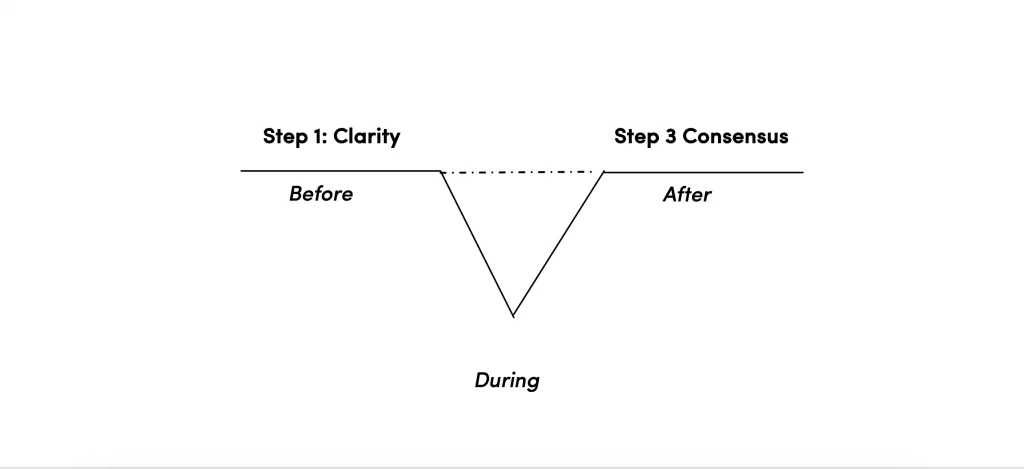
Share This Post
In this article I will share a tool that we have used for several years now and which has shown to be very effective for succeeding as a leader. The article is also published in the Danish news media: Berlingske. You can read it here but only in Danish.
In this article you’ll get:
- A ready to use model for succeeding as a leader
- An explanation of the model
- A hands on example from real work life with Adam who transform into a cherished leader.
“People have been falling like flies”. One after the other they leave the company or get on long sick leaves”, he says. It is not just his direct reports. It is also the people who just have dotted lines to him or people who needs to collaborate with him. I get this call from a distressed leader, who is asking me to help a leader in the organization who is strategically vital to the company. Let’s call him Adam.
We start the coaching process slowly talking about his life and experiences. It is the first time he is talking to a coach. Previously, he has just participated in leadership trainings on fancy world class business schools. But Adam has never thought about what it means for him to be a leader. Him personally. Talking about how he is with other people and how he can motivate, inspire, follow up, support and keep his team engaged in a relating way is new to him. Everything on leadership he has been presented to before did not have anything to do with him personally.
Leadership is personal
Leadership is personal. It is you as a leader who is relating, motivating, inspiring following up, supporting, and keeping people engaged. It is very personal. You are the medium for the leadership you are exercising. To dive into the aspect of why leadership is personal. Please read my article from Fast Company here.
The personal part of leadership has two dimensions. There is what I refer to as the vertical part of leadership. That has to do with your being. There is also a horizonal part that related to your doing. So, your very presence and awareness is in the vertical part, while the horizonal is related to how you communicate and act.
Are we skilled enough to lead? Most complex projects actually do not succeed. For example, the analysis company Gartner estimates that 55-75 percent of all ERP projects (enterprise resource planning systems) do not achieve the desired effect due to inadequate leadership, while research from SDU shows that about 70 percent of organizational changes do not succeed.
Use the 1,2,3 Leading Successfully Model

The 1, 2, 3 Leading Successfullly Model© gives a framework for you to relate not only to what you say and do, but also to how you are. For some time now, I have shared the 1,2,3 model with many leaders. In groups and one to one. The 1, 2, 3 Leadership Model© was created through numerous reflections with those leaders. And upon that we have created a Leadership Development Community where you e.g., will learn how to use the model for your leadership success. You can take a closer look at the community here
Step 1: Clarity
Before any project, hiring, or task, it is crucial that everyone knows what success looks like. Expectations for both the process and result must be aligned very concretely using examples and goals.
Step 2: Connection
With a connection, you relate yourself to the matter and the person. It is a form of check-in where the leader, with personal empathy, gets a sense of the status. Such check-ins can easily be short. But they require mental presence. Empathy requires that you mentally and emotionally can relate to how it is to be in the other persons shoes. It does not imply that you have to lead from emotions, as too many leaders think. If you would like to learn more about empathy in leadership then, read more in this article.
As you may have noticed, step 2 is in a step down. This is because people often don’t check in until something is going off track. Once in a situation where things are going off track, people can potentially get mentally hijacked. You can read more about the ready/hijacked concept here. If someone has been mentally hijacked, the leader must create calmness and safety. If the employee is hijacked, the leader cannot correct, give feedback, or explain what needs to be done – because they cannot take in new complex information. However, if there is no clarity about goals and direction (as what should have been set in step 1), it can be clarified in this step. But say it briefly and clearly – and wait with feedback.
Step 3: Consensus
After this, and when there is mental calm, feedback can be given, or alignment can be done in other ways so that everyone has a shared understanding of what has happened and what should happen next. Consensus can be achieved at conclusions, but also after a step or milestone is reached, or at a regular one to one.
The shared perspective should include whether the task has been solved satisfactorily in a proper way, and whether one has succeeded. This is something everyone – even experienced senior employees – needs to talk about. Too often, successful employees with gray hair do not get the sparring or recognition that all people need from time to time. So, remember them too.
Learn how to use the model for your leadership success. Get the guide here
How the 1,2,3 leadership model made sense for Adam
Circling back to Adam. His leadership style unintentionally had major personal consequences for people who worked with him. It was not that he did not know. But he did not know how to do better. We talk about him as a person. His default behaviors are that he like to sit by himself doing analysis and crunching numbers – alone. He is extremely good at that. He never had a positive team experience to rely on. Now, he has to invent his vision for his team and how he wants to be with people he collaborates with. He wants to put away the behavior that creates the negative consequences that breaks down people. It was unintentionally. Because he did not know how to do it differently.
I share the 1,2,3 model with Adam. We use it as a framework to talk about how to create clarity, connect with people individually and how to create connections within the team to make it a team that people love being part of – and how to create consensus. For example: He changes the vertical aspect of his leadership style (his being), by being aware of that he is prone to close himself with two three things. 1) He is paying attention to his own behavior trying to be more open. He keeps the door to his office open and let his people know that they can always come in. 3) He prepares team gatherings, where he shares what is on his mind and where they also can relate to one another. It is groundbreaking for him. Though his effort his life enriches with a new experience, how it is to be part of a team where people are engaged and feel that they belong. Once we finished his coaching process he tells me, “I never knew that leadership could be so interesting – and that in practice it was so much about me as a person”. A few years later he is leaving the organization. I hear from other leaders and HR that they are so sorry that he is leaving. He has become a cherished leader.
It might sound like magic. But we are not magicians. We do leadership development. The changes good collaboration between us and our clients does sometimes seem like magic.
Invest a little time – it pays off
How the 1,2,3 leadership model made sense for Adam
The most successful organizations, like McDonald’s and Novo Nordisk, are also the best at continuously investing both time and money in leadership development, even when they are busy. This affects their employee retention, well-being measurements, and results. They choose leadership development over something else. They cannot afford not to – because they know that good leadership is crucial to achieving their goals.
You will see the same pattern among successful and happy people. They invest time and money in their development.
Good leadership is incredibly necessary today. It has become much harder to feel successful. The pace of change and complexity in our world is increasing. At the same time, both time and place for work are fluid. Add to this all the broken dreams of a happy life with the one and only and the harmonious family life, along with failing health, pain, poor sleep, etc. For it is the sum of things that succeed or fail in one’s life that determines whether one feels capable of succeeding as a person – and as a leader.
Coaching is a very effective leadership development method. So, maybe you should consider coaching – helping to deal with your real challenges. Reach out or take a closer look at the coaching page.
And remember that we help people in multinational companies developing leadership to realize dreams. If you would like to be updated with new articles and videos, sign up for our mailing list. Your mail is not shared with anyone and there are advantages to being on the list e.g., getting the first chapter of my book, Power Barometer – How to Manage Personal Energy for Business Success.












